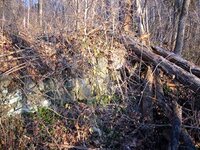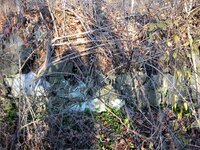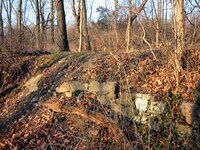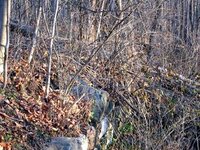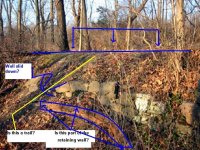funkman
Bronze Member
i was out this morning for an hour hunt before going to work...and it was cold! Well I went back to my ATV trails to search the same area where I think was a trash pit. Well I found some more melted metal and some nails. Figured I would search somemore along what i thought was a retaining wall. Now that most of the brush and vegetation has disappeared, it is starting to look like I might have found the foundation I was looking for. It seems that the retaining wall I thought could actually have been part of the foundation. The only crazy thing is this...and this is where you experts are needed. Picture this in your minds. You have a flat area and then there is a drop of about 3 or 4 feet. This drop has all these stones that run for about 50-100 feet in lenght. This is what I think was one side of the foundation. Now at the bottom of this drop is another flat area where I found all the burnt items and broken bricks and shards of pottery and glass and melted metal...you get the picture. In this area I also found the 1862 English penny. Now this flat area has another drop off of again about 3 or 4 feet. There are no stone walls that I can see in this drop off, just dirt. So to draw you a cross section it would look like this:
____________________ A
| stone wall
|
___________________ B
| dirt slope
|
_____________________ C
So section A is the topmost flat area, section B is the area where alot of iron and artifacts are coming from, and section C is another flat area.
Now why would there be a flat area on section A, the stone wall, flat area of section B, the dirt slope and another flat area of section C? I can so far only see the one stone wall/foundation and do not understand why there would be no other stone wall and also why there is sort of a step from one section to another (A to B and B to C) I would think if it was a foundation that it would like like this:
flat area flat area
________________________ ____________________
| < Stone walls > |
|______________________|
Anyway. take a look at my stone wall pics and let me know what you all think....foundation or just retaining wall.
Thanks and I will answer any questions that come up.
Funkman
____________________ A
| stone wall
|
___________________ B
| dirt slope
|
_____________________ C
So section A is the topmost flat area, section B is the area where alot of iron and artifacts are coming from, and section C is another flat area.
Now why would there be a flat area on section A, the stone wall, flat area of section B, the dirt slope and another flat area of section C? I can so far only see the one stone wall/foundation and do not understand why there would be no other stone wall and also why there is sort of a step from one section to another (A to B and B to C) I would think if it was a foundation that it would like like this:
flat area flat area
________________________ ____________________
| < Stone walls > |
|______________________|
Anyway. take a look at my stone wall pics and let me know what you all think....foundation or just retaining wall.
Thanks and I will answer any questions that come up.
Funkman


